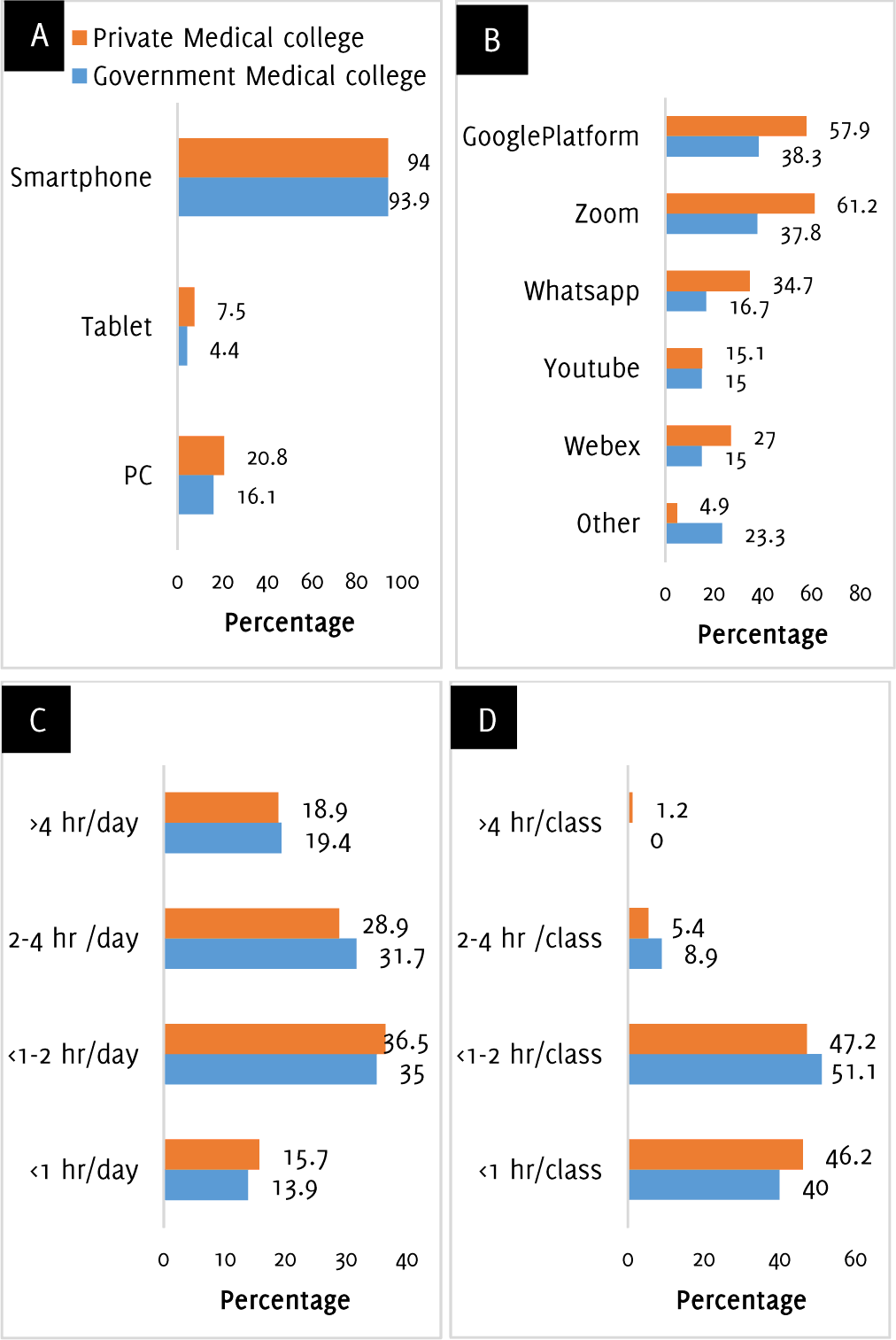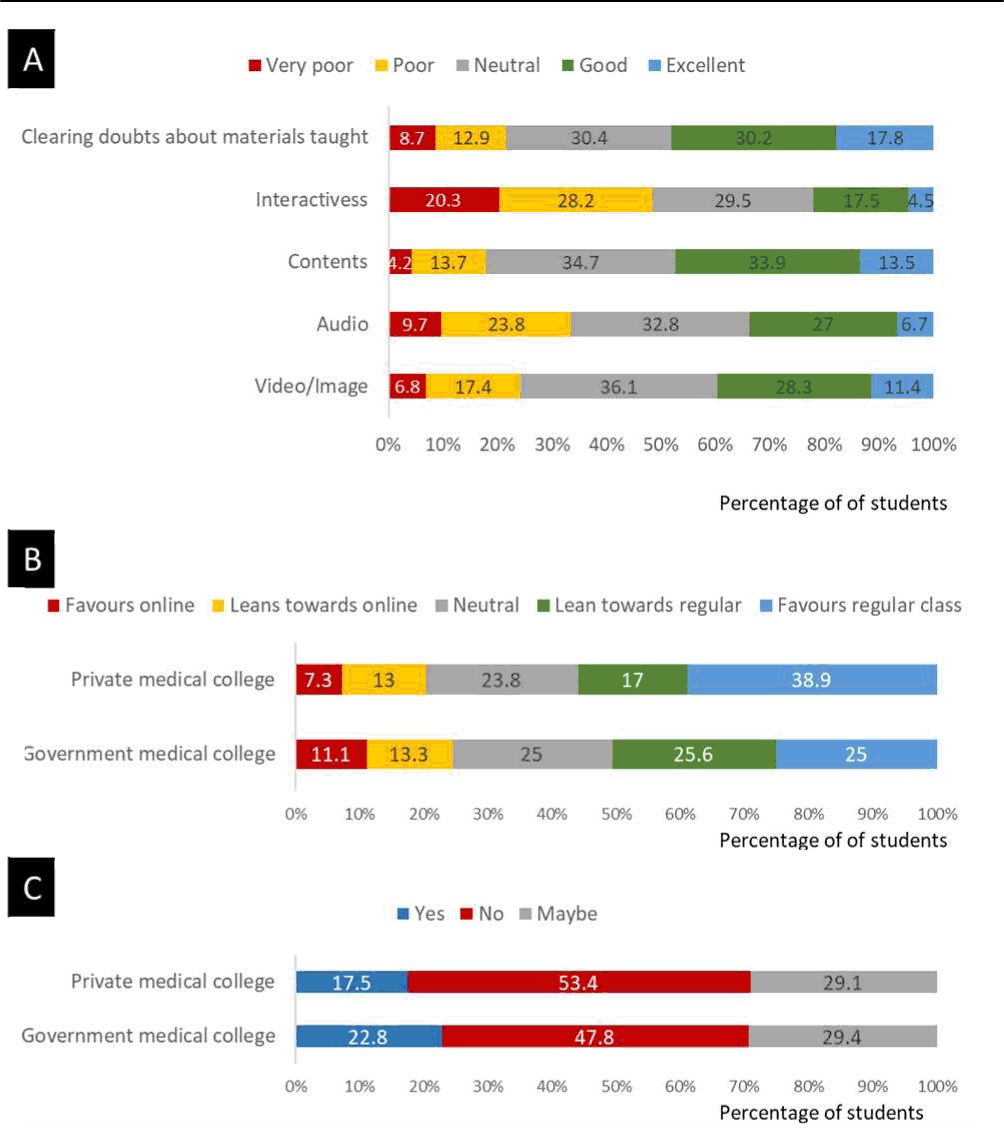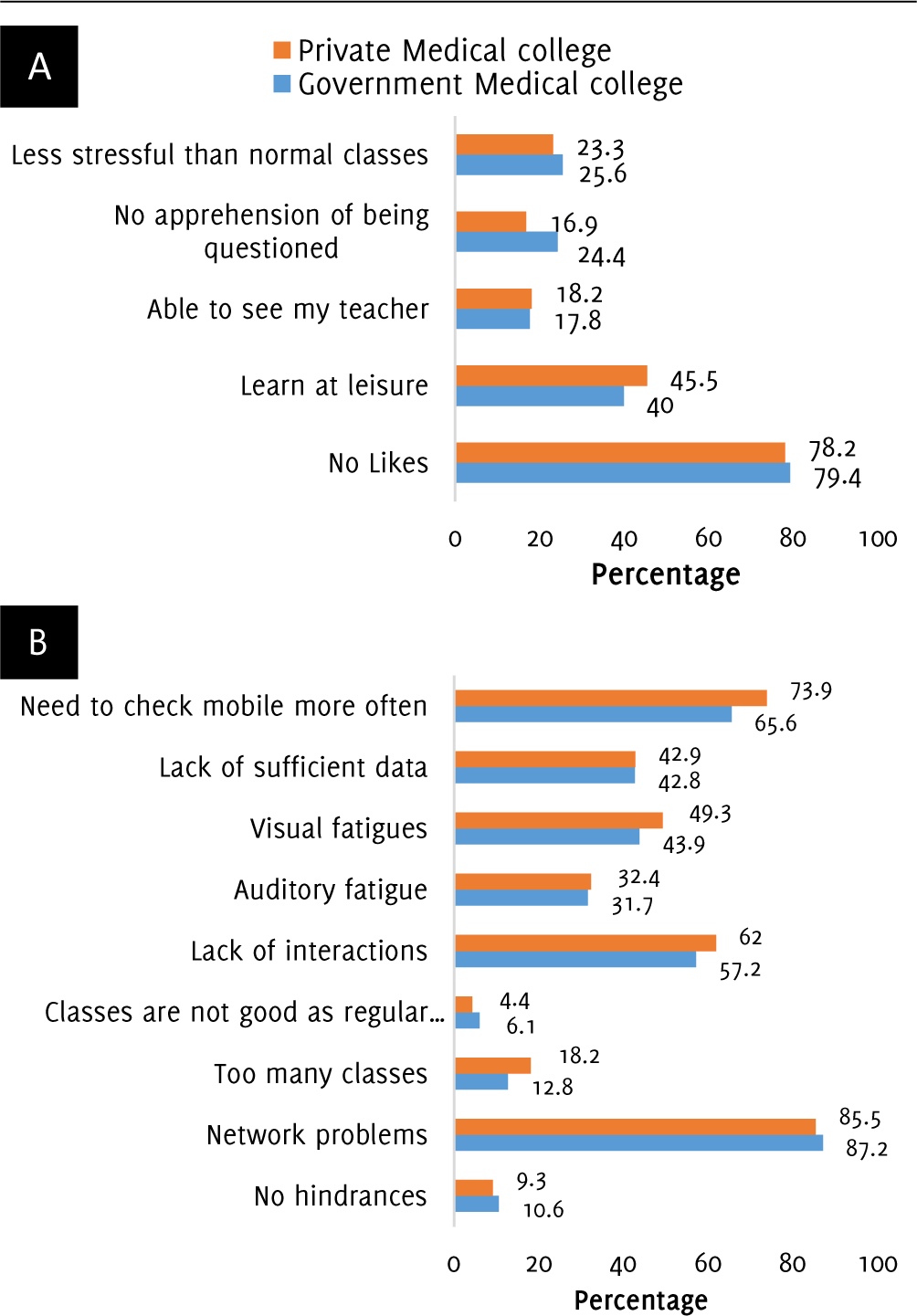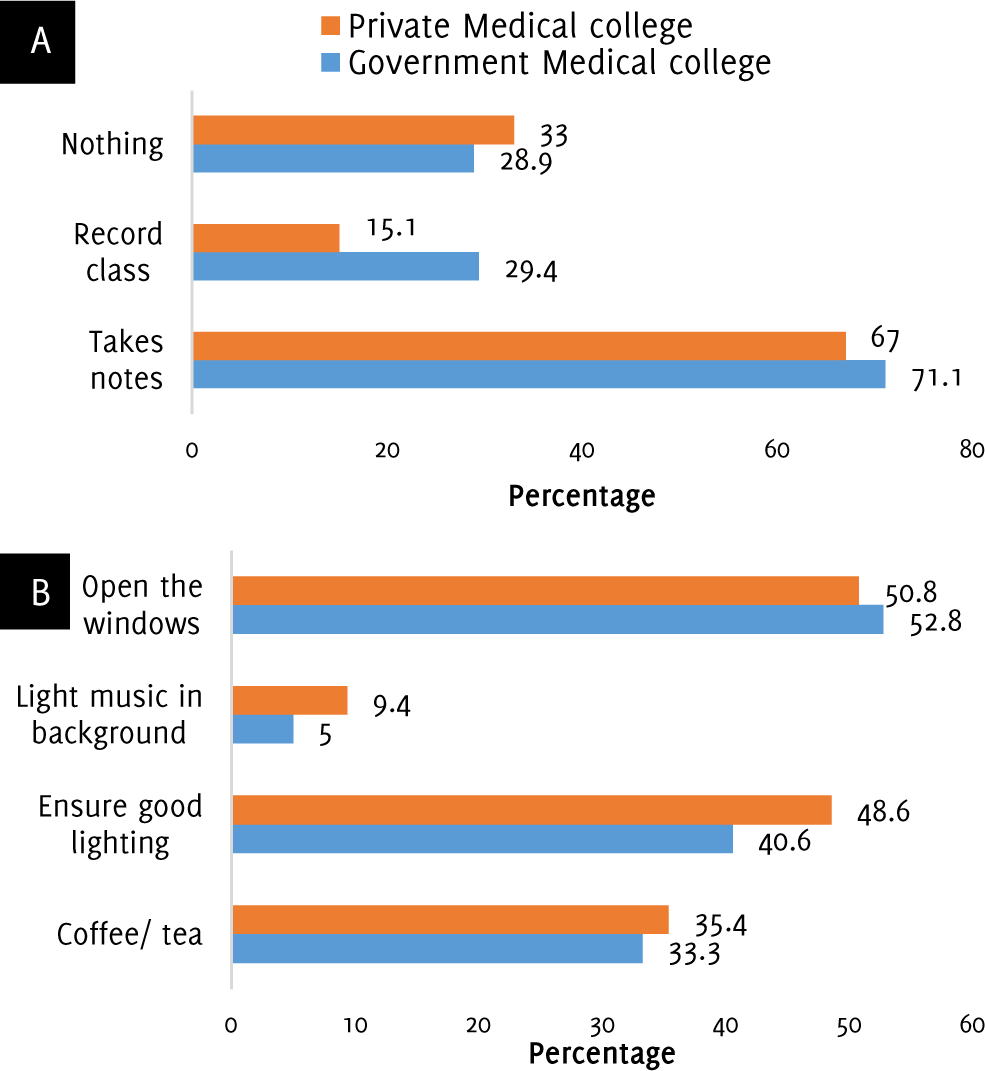Comparison of Private Medical College vs. Government Medical College in Terms of: A. Devices; B. Platforms; C. Duration of Classes per Day; D. Duration of Average Class

Andrew Thomas1, Mohan T. Shenoy2, Kotacherry T. Shenoy3, Sruthi Suresh Kumar1, Aboobakker Sidheeque1, C. Khovidh4, Jayakumar Parameshwaran Pillai5, Pramod Murukan Pillai6, Shana Sherin C. H7, Anna Mathew8, Twinkle Zakkir9, Sreelakshmi Dileep10, Victory Mekha11, Sony Raju12, Mohammed Junaid K.13, Sivendu P.14
doi: http://dx.doi.org/10.5195/ijms.2020.571
Volume 8, Number 2: 102-106
Received 17 05 2020: Rev-request 26 05 2020: Rev-request 04 06 2020: Rev-request 08 07 2020: Rev-recd 28 05 2020: Rev-recd 08 07 2020: Accepted 30 07 2020
ABSTRACT
Background:In view of COVID-19 lockdown in India, many colleges started online classes. This study aimed to evaluate the attitudes of, and the factors affecting, medical students attending online classes during lockdown.
Methods:We designed an online questionnaire with open-ended, close-ended, and Likert scale questions. Links to the questionnaires were shared with the medical students who have attended at least one online class during the COVID-19 lockdown period. Respondents were 1061 participants from 30 medical colleges from the states of Kerala and Tamil Nadu in India.
Results:The majority of students – 94% (955/1016) – used smartphones to attend online classes. ZOOM/Skype – by 57.1% (580/1016) – and Google platforms – by 54.4% (553/1016) – were commonly used. Learning at leisure – 44.5% (452/1016) – was the top reason why students liked online classes, whereas network problems – 85.8% (872/1016) – was the top reason why students disliked them. Lack of sufficient interaction – 61.1% (621/1016) was another reason why students disliked online learning. More than half the participants – 51.7% (526/1016) – did not want to continue online classes after COVID-19 lockdown. More students – 55% (558/1016) – favored regular classes than online classes.
Conclusion:Students in our survey did not seem favorably disposed to online classes. Network problems experienced by students should be addressed. Furthermore, teachers should try to make the classes more interactive and educational institutions should address the problems pointed out by the students in order to make online classes more effective in the future.
Keywords: COVID-19; Lockdown; Cross-sectional survey; Undergraduate medical education; Medical students (Source: MeSH-NLM).
Coronavirus disease (COVID-19) has been reported in 216 countries and has affected more than 5.4 million people1. The World Health Organization (WHO) on March 11, 2020 declared this disease to be a pandemic2. The first case of COVID-19 in India was confirmed on January 30, 20203. In order to contain the spread of disease, India declared a national lockdown starting from 24 March, 20204. Even with increased pathogen exposure, additional working hours, stigma and violence, health care workers still continue to be on the front line for preventing and treating COVID-19 disease. Educational institutions were shut down because of the lock-down; however, many medical students all around the world were involved in voluntary duties to control COVID-19. Colleges started online classes to ensure continuity of education. India is not new to online education. Study Webs of Active-Learning for Young Aspiring Minds (SWAYAM), an integrated web portal, conducts online education from the high school to the university level5. However, being a developing country, many areas of India lack reliable network and internet coverage. Many students cannot simply afford the extra cost and equipment needed to utilize online learning to its full potential.
Medical undergraduate education (MBBS) is a four and a half years program with one-year compulsory internship in hospitals. With 542 medical colleges and with a capacity of almost 79,000 medical students6, updated competency-based curriculum requires students to acquire experience in various practical skills. Understanding complex pathologies and procedures demands more interaction and discussions with teachers. This is not possible without clinical rotations. The final year undergraduates spend most of their time on hospital wards, perfecting their history-taking and examination skills prior to university exams.
The use of technology in education is inevitable and online education seems to be the only logical solution during lockdown. From creating emails and connecting via WhatsApp groups, now communication is mainly by web-based live video conferencing platforms (WebEx, Skype, Zoom, Microsoft Teams), and teaching web platforms (Moodle, Google Classrooms). The success of online education depends on addressing the disparity across learning resources, use of technology, communication tools and the ability to understand information from sources like computers and mobile phones7,8. A systematic review and meta-analysis from China in 2019 that included 16 articles observed no significant differences between online and offline learning. Furthermore, post-test test scores even showed significant improvement among students who took online learning9. A survey of online class participants would give us an idea of which areas to concentrate upon. With this rationale, we collected the opinion of medical students who have attended the online classes and their perceptions on continuing online classes in the “new normal” era.
We conducted a cross-sectional survey using Google forms. A semi-structured questionnaire comprising 25 questions was pilot-tested for the content and structure. Undergraduate medical students who attended at least one online class were included in the study. This study was approved by the Institutional Research Cell (IRC) and the Institutional Ethical Committee (IEC) of Sree Gokulam Medical College and Research Foundation, Kerala.
The questionnaires were self-administered in English using Google Forms (Google LLC, CA, and U.S.A.). It was distributed among WhatsApp groups (WhatsApp Inc, CA, U.S.A.) of students among medical colleges in the states of Kerala and Tamil Nadu. The questionnaire was available online for 48 hours (from May 03, 2020 to May 05, 2020). All the participants were informed about the aims, benefits and implication of the study and consent was obtained before starting the survey. A restriction on the number of responses from a single email-address was enforced to prevent duplicate responses from the participants. Completed data as obtained in Google forms with response rate was 100%.
The questionnaire comprised of four sections: the first section included socio-demographic details (gender, semester, government or private college, and pin code of the college). The second section included details on online classes they attended over the last 14 days (April 18, 2020 to May 02, 2020). These included types of devices, platforms used by students and duration of classes. The third section was on the students’ perception of online classes. A five-point Likert scale10 was used to determine the perception of audio, video quality, content, interactiveness and discussion of doubts. The responses were categorized into five: very poor, poor, neutral, good and excellent. The fourth section was on students’ like and dislike; suggestions and practice. We encouraged participants to select multiple answers for questions on likes and dislikes, devices, platforms, practice and suggestions. The data was extracted from the Google forms and analyzed using SPSS version 25 (Statistical Package for the Social Sciences, SPSS Inc, U.S.A) to compare the outcome of private institutions with that of government institutions.
Self-declared information from 1016 students from 30 medical colleges from the states of Kerala and Tamil Nadu were included. All participants who entered the survey responded to each question. Answers on likes and dislikes, devices, platforms, practice and suggestions for online classes had considerable overlap. Gender and semester distributions are represented in Table 1. The majority of responders – 443 (43.6%) – were from the sixth and the eighth semesters (Table 1).
Table 1Distribution of participants by Gender, Semester in Government and Private Medical Colleges.
| Variables | Government Medical college | Private Medical college | Total | p-value | ||||
|---|---|---|---|---|---|---|---|---|
| N | % | N | % | N | % | |||
| Gender | Male Female |
74 106 |
41.1 58.9 |
269 567 |
32.2 67.8 |
343 673 |
33.8 66.2 |
0.021 |
| Semester | First and Second (1st year) | 85 | 47.2 | 154 | 18.4 | 239 | 23.5 | |
| Third semester | 3 | 1.7 | 60 | 7.2 | 63 | 6.2 | ||
| Fourth semester | 4 | 2.2 | 89 | 10.6 | 93 | 9.2 | ||
| Fifth semester | 2 | 1.1 | 51 | 6.1 | 53 | 5.2 | <0.001 | |
| Sixth semester | 13 | 7.2 | 172 | 20.6 | 185 | 18.2 | ||
| Seventh semester | 5 | 2.8 | 46 | 5.5 | 51 | 5 | ||
| Eighth semester | 65 | 36.1 | 193 | 23.1 | 258 | 25.4 | ||
| Ninth semester | 3 | 1.7 | 71 | 8.5 | 74 | 7.3 | ||
Comparison of Private Medical College vs. Government Medical College in Terms of: A. Devices; B. Platforms; C. Duration of Classes per Day; D. Duration of Average Class

Most students – 955 (94%) – used smart phones. ZOOM/Skype and Google platforms were used by 580 (57.1%) and 553 (54.4%) students respectively. The majority – 667 (65.6%) – of the students had one to four hours of online classes per day. A total of 945 (93%) attended classes lasting less than two hours.
Participants were asked to rate five components of online class using a five-point Likert scale, which included clearing doubts, interactiveness, contents of the class, audio quality and video/image/slide quality. This is summarized in Figure 2.
Figure 2Participants’ Perception: A. Rating B. Preference C. Whether to Continue Online Class after Lockdown.

Participants’ attitude (A) Likes (B) Dislikes regarding Online Classes.

Learning at leisure – 452 (44.5%) – was the top reason for liking online classes, although over three-fourths – 797 (78.4%) – of the participants disliked online classes. Network problems 872 (85.8%), the need to check their mobiles more often 736 (72.4%) and the lack of interaction 621 (61.1%) were the top factors that the participants disliked about online classes. Almost half the participants – 491 (48.3%) experienced visual fatigue after attending online classes. Only 97 (9.5%) of the participants experienced no hindrance while attending online classes.
One-third of the participants – Figure 4 A, 328 (32.3%) – did not do anything while attending online classes. However, 688 (67.7%) and 179 (17.6%) students took down notes and recorded the classes, respectively. We asked the students for factors that would increase their ability to participate in the class. The responses were summarised in Figure 4 B.
Figure 4Students’ (A) Practice and (B) Suggestions about Online Classes comparing Private Medical College vs. Government Medical College

To the best of our knowledge, there have been no studies on the students’ perspectives of online classes during COVID-19 lockdown in India. Our survey included 1016 students from 30 medical colleges – 836 (82.3%) from the private and 180 (17.7%) from the government sector. This was because many government colleges have not started online classes yet. Among the participants, 673 (66.2%) and 343 (33.8%) were females and males, respectively. This is on par with the institutional structure. Due to temporary shutdown of schools and colleges, COVID-19 had seriously affected the education of over a billion students’ world-wide. This is almost 68% of total enrolled students globally11.
Online education is challenging in developing countries like India, because of poor network coverage in remote areas. India is second only to China in terms of internet users with the internet user penetration rate of 50%. This implies that nearly half of the country's population has no access to Internet12. In our study, the mobile phone was the predominant medium used for online learning 955 (94 %). Many students still use smart phones which are not optimized for attending online classes. Now, medical students have access to a wide range of learning materials during lockdown. Students can look at complex procedures and diseases that cannot be seen in remote or smaller institutions. Khurana et. al. reviewed the pros and cons of various mediums that can be used by medical students13. Craddock et. al. observed that pediatric residents who used an online module for learning atopic dermatitis showed statistically significant improvement in disease-specific knowledge when compared to controls14. Shah et. al. initiated a satellite school in India in 2006 which evoked tremendous response because of its ability to teach techniques in remote places via telemedicine15.
In our study, ZOOM/Skype platform was utilized by 580 (57.1%) and Google platforms by 553 (54.4%) with overlap in use of applications. On the whole, the participants rated ‘average’ to ‘good’ for factors like video, audio, content and clearing of doubts on content covered during the lectures. Online classes lack insufficient interaction. The general frustration of COVID-19 lockdown made 526 students (51.7 %) feel that they did not want to continue online classes. Regular classes were favored by 370 (36.4 %) whereas online classes were preferred by 81 (8%) of the participants. Students are likely to perform better when the components of online and offline classes are mixed judiciously. This is called “blended education”. E-learning modules in higher education will be successful, if teachers and students integrate online classes into the current curriculum17,18,19. There is practically very little experience of online classes within the existing medical curriculum. In order to observe social distancing norms, educational institutions with limited resources have to struggle to support their students. This puts an additional burden on medical teachers, who are working during COVID-19 crisis, as they have to tackle pedagogical and clinical responsibilities simultaneously. Additionally, students face many hassles while attending online classes. They are unanimous in stating that teachers must explore ways to make their classes more interactive to improve the students’ attention span.
One limitations of this study was that we included the viewpoint of only students. The teachers’ opinion was a part of the study; however, due to anticipated delay in data collection, we could not include their data in present study. Secondly, we included students from medical colleges in south India as they were relatively easy to access and Kerala was one of first to start conducting online classes. Thirdly, comparison between government and private college was analyzed by descriptive statistics (Chi square) as we did not have a priori hypothesis.
The concept of online classes is still evolving. Network problems experienced by the students should be addressed. Scheduling classes in advance, trying to minimize the duration of classes and giving short breaks would minimize fatigue and improve interactions. It is appropriate that educational institutions adhere to the “new normal “-blended learning approach after the lockdown period.
We thank Dr Radhika for the language editing of final draft.
The Authors have no funding, financial relationships or conflicts of interest to disclose.
Conceptualization: AT, SKT. Data Curation: AT, MTS, SKT, SSK, CK, JPP, PMP, SSCH, AM, TZ, SD, VM, SR, MJK, SP. Formal Analysis: AT, MTS, SKT, AS. Funding Acquisition: AT. Methodology: AT, SKT. Investigation, Project Administration, Resources, Supervision, Validation, Visualization, Writing – Original Draft Preparation, & Writing – Review & Editing: AT, MTS, SKT.
1.World Health Organization. Coronavirus disease (COVID-19) Pandemic. Available from: https://www.who.int/emergencies/diseases/novel-coronavirus-2019. Last updated May 27, 2020; cited May 27, 2020.
2.Cucinotta D, Vanelli M. WHO Declares COVID-19 a Pandemic. Acta Biomed. 2020 Mar 19;91 (1):157–160.
3.Sarkale P, Patil S, Yadav PD, Nyayanit DA, Sapkal G, Baradkar S, . First isolation of SARS-CoV-2 from clinical samples in India. Indian J Med Res. 2020 Feb & Mar;151(2 & 3):244–250.
4.Lamba I. Why India needs to extend the nationwide lockdown. Am J Emerg Med. 2020 Apr 15: S0735-6757 (20)30254–0.
5.Majumder C (2019). SWAYAM: The Dream Initiative of India and its uses in Education. International Journal of Trend in Scientific Research and Development. 2019 Apr: Volume-3. 57–60.
6.Medical Council of India (MCI). List of colleges teaching MBBS. Available from: https://www.mciindia.org/CMS/information-desk/for-students-to-study-in-india/list-of-college-teaching-mbbs. Last updated May 13, 2020; cited May 16, 2020
7.O'Doherty D, Dromey M, Lougheed J, Hannigan A, Last J, McGrath D. Barriers and solutions to online learning in medical education - an integrative review. BMC Med. Educ. 2018 Jun 7;18 (1):130.
8.Kim KJ, Kim G. Development of e-learning in medical education: 10 years’ experience of Korean medical schools. Korean J Med Educ. 2019 Sep;31 (3):205–214.
9.Joshi A, Kale S, Chandel, Pal D.K. Likert Scale: Explored and Explained. Br J Appl Sci Technol. 2015 Feb; Volume 7, pp 396–403.
10.The United Nations Educational, Scientific and Cultural Organization. COVID-19 Impact on education. Available from: https://en.unesco.org/covid19/educationresponse. Last updated May 27, 2020; cited May 27, 2020.
11.Statista Research Department. Internet usage in India-Statistics & Facts. Available from: https://www.statista.com/topics/2157/internet-usage-in-india/. Last updated May 08, 2020; cited May 27, 2020.
12.Khurana Mark P. Learning under lockdown: navigating the best way to study online BMJ 202; 369:M128.
13.Craddock MF, Blondin HM, Youssef MJ, Tollefson MM, Hill LF, Hanson JL, . Online education improves pediatric residents’ understanding of atopic dermatitis. Pediatr Dermatol. 2018 Jan;35 (1):64–69.
14.Shah D. Online education: should we take it seriously? Climacteric, 2016, 19:1, 3–6
15.Means B, Toyama Y, Murphy R, Bakia M, Jones K. Evaluation of evidence-based practices in online learning: A meta analysis and review of online learning studies. Washington DC: US Department of Education. 2009, May.
16.Michael P. A, Murphy. COVID-19 and emergency eLearning: Consequences of the securitization of higher education for post-pandemic pedagogy, Contemporary Security Policy, 41:3, 492–505
17.Dziuban C, Graham C. R, Moskal P. D, Norberg A, Sicilia N. Blended learning: the new normal and emerging technologies. Int J Educ Technol High Educ 15, 3 (2018).
18.Kukolja-Taradi S, Dogas Z, Dabić M, Drenjancevic Perić I. Scaling-up undergraduate medical education: enabling virtual mobility by online elective courses. Croat Med J. 2008.
Andrew Thomas, 1 Medical student, Sree Gokulam Medical College and Research Foundation, Trivandrum, India
Mohan T. Shenoy, 2 MBBS, MD, DM. Department of Endocrinology, Sree Gokulam Medical College and Research Foundation, Trivandrum, India
Kotacherry T. Shenoy, 3 MBBS, MD, DM, FRCP. Head of Department of Gastroenterology, Chairman of Institutional Research Cell (IRC), Sree Gokulam Medical College and Research Foundation, Trivandrum, India
Sruthi Suresh Kumar, 1 Medical student, Sree Gokulam Medical College and Research Foundation, Trivandrum, India
Aboobakker Sidheeque, 1 Medical student, Sree Gokulam Medical College and Research Foundation, Trivandrum, India
C. Khovidh, 4 Medical student, SRM Medical College Hospital and Research Centre, Chennai, India
Jayakumar Parameshwaran Pillai, 5 MSc. Department of Biochemistry, Government Medical College, Trivandrum, India
Pramod Murukan Pillai, 6 Medical student, Sree Narayana Institute of Medical Sciences, Ernakulam, India
Shana Sherin C. H, 7 Medical student, Believers’ Church Medical College, Thiruvalla, India
Anna Mathew, 8 Medical student, Pushpagiri Medical College, Thiruvalla, India
Twinkle Zakkir, 9 Medical student, Travancore Medical College, Kollam, India
Sreelakshmi Dileep, 10 Medical student, Government Medical College, Kannur, India
Victory Mekha, 11 Medical student, Malabar Medical College Hospital and Research Centre, Calicut, India
Sony Raju, 12 Medical student, Government Medical College, Thrissur, India
Mohammed Junaid K., 13 Medical student, Al Azhar Medical College & Super Specialty Hospital, Idukki, India
Sivendu P., 14 Medical student, KMCT Medical College Hospital, Calicut, India
Francisco J. Bonilla-Escobar, Editor
Madeleine Jemima Cox, Student Editor
About the Author: Andrew Thomas is currently a final year medical student of Sree Gokulam Medical College and Research Foundation, Trivandrum, India. He is also a recipient of Short-Term Studentship 2019 by ICMR (Indian Council of Medical Research), Best paper award at NATCON 2019, Government medical college, Trivandrum.
Correspondence: Andrew Thomas, Address: Aalamthara - Bhoothamadakki Rd, Venjarammoodu, Kerala 695607, India Email: drandrewthomasj@gmail.com
Cite as: Thomas A, Shenoy MT, Shenoy KT, Suresh Kumar S, Sidheeque A, Khovidh C, et al. Survey Among Medical Students During COVID-19 Lockdown: The Online Class Dilemma. Int J Med Students. 2020 May-Aug;8(2):102-6.
Copyright © 2020 Andrew Thomas, Mohan T. Shenoy, Kotacherry T. Shenoy, Sruthi Suresh Kumar, Aboobakker Sidheeque, C. Khovidh, Jayakumar Parameshwaran Pillai, Pramod Murukan Pillai, Shana Sherin C. H, Anna Mathew, Twinkle Zakkir, Sreelakshmi Dileep, Victory Mekha, Sony Raju, Mohammed Junaid K., Sivendu P.
This work is licensed under a Creative Commons Attribution 4.0 International License.
International Journal of Medical Students, VOLUME 8, NUMBER 2, August 2020